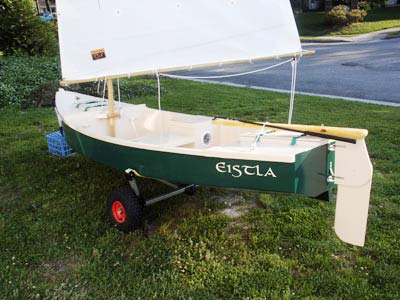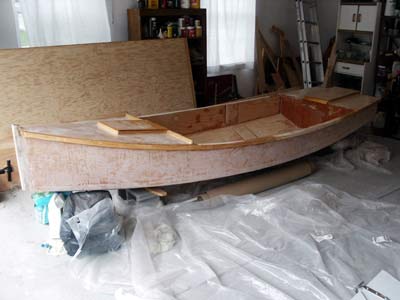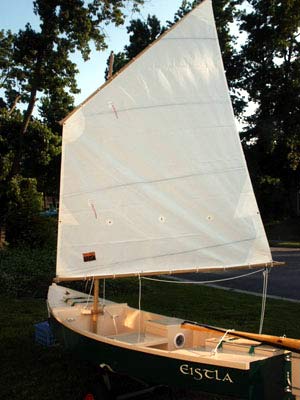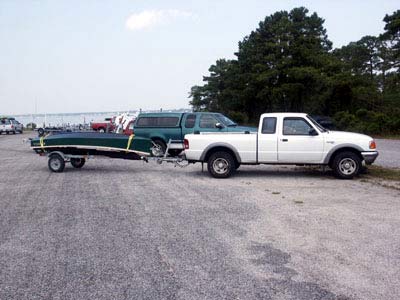Mixer
I got a chance to row my Mixer
6 miles yesterday. Now, I've rowed a total of about 0.5 miles
in my whole life, so this was a bit of a milestone for me. My
Mixer is set up for primarily sailing, but I wanted to see what
the rowing performance was and to start preparing myself for
a major future possible "event."

The first 3 miles were into adverse
current and wind. There were also lots of powerboaters doing
their thing, specifically, churning the water up into washing-machine
style waves. Perfect testing conditions if I may say so.
This rowing thing takes some
practice. I started out with poorly adjusted buttons, I gripped
the handles too hard (I have 3 blisters on my left hand as a
result), and I splashed myself quite a few times. But after
properly adjusting the buttons, adjusting my rowing stance a
little, rowing over stumps, and relaxing my hands on each stroke,
I finally found a nice rowing groove that was most pleasant
and I could keep up all day (fortunately for my blisters I didn't
have to).

Boat performance: I wasn't rowing
as hard as I could have; I was going a pace that I could keep
for long term. Against the wind and current I averaged 2 knots.
The wind would knock the boat around a bit, both upwind and
down. Often the boat would respond before I could feel the puff.
This was not unexpected, since the rocker keeps the stem and
the transom clear of the water. I've installed a skeg, but not
really for tracking purposes. If I had put on the rudder, that
might have helped. Banging into the chop slowed me down, too.
Once I was clear of wind and in calm water, the speed picked
up dramatically. After I turned around and went with the wind
and current I averaged 3 knots. Not a blistering pace, but respectible
for a 12 ft. boat.
One problem I had was the oarlocks.
I have closed bronze locks, and the angle I need to put the
oars in the water was enough to bend them at the top of the
shaft. I might try open locks next time.
After my blisters heal
a bit, that is.

The rowing test completed, I
had to wait to the next available weekend to try sailing my
Mixer. This time I had my son along with me to add an element
of "family outing" to the event. Conditions were similar
to the rowing trip-same ramp, same choppy water from all the
speeding powerboats, and a bit more wind. But the breeze was
puffy, squirrelly, and cantankerous. Once again, perfect conditions
for sailing sea trials.
The tide was unusually low, so
most people were having trouble launching their boats. I didn't,
since I used the Seitech dolly, but I had to wait a bit for
a ramp to clear. Once launched, I hoisted the sail and prepared
for getting underway while my son held the boat near the dock.
During the maiden voyage and the rowing test, I was impressed
by the Mixer's stability. But soon I was inadvertently testing
an extreme case. In rushing to depart the launching area, I
was giving instructions to my son on how he needed push us when
he let go of the dock. You see, sailing terminology is not part
of my son's vocabulary. "Haul away to starb'rd," "Avast
heaving," and "Trice the main brace!" will go
right over a 9 yr. old's head. So in the process of explaining
"push the bow off to starboard" in laymen's terms,
I found myself in the front part of the cockpit with my 65 lb.
son standing on the foredeck and both of us trying to reach
the dock ahead of us. In all of the dinghies I've sailed, this
maneuver would've meant a very quick trip into the drink. But
surprisingly this was not the case. In the end, my son was able
to get back into the cockpit, go around me to the stern, and
we were able to get underway without the boat upending us. Not
bad for a 12 ft. dinghy.

We got a nice puff to help us
away from the dock, and soon we were creating a nice wake. And
just as soon the boat pitched forward while grinding to a nice
halt. Well, it was good confirmation that the tide was unusually
low. It was also a great stress test of my daggerboard box,
a modification I made to the original design. It didn't fall
apart so that's good. With the daggerboard up a bit, we roceeded
into deeper water.
After stopping on a quiet beach
for lunch, we got underway for an earnest sailing test. The
sailing rig on the Mixer is a balanced lug sail. The mainsheet
is a 2:1 ratio. I race a Sunfish regularly, and it has a 1:1
mainsheet with a 75 sq. ft. sail. When the breeze picks up over
15 kn it can be a bicep burner to haul it in. Even though the
Mixer's sail is slightly smaller at 68 sq. ft., I was happy
to have the extra purchase during the puffs. We sailed to weather
very well, tacking around 90 degrees. During the stronger breezes
the top yard would twist off, bleeding off power from the upper
part of the sail. Almost like it was designed to do that. Feathering
the luff was also possible and still have forward driving power.
Only a little weather helm was necessary, even when healing.
And speaking of healing, once we got to around 25 - 30 degrees
water started pouring over the rail. Part of our cockpit arsenal
was a large plastic cup, the kind you get at 7-11 when you biggie-size
it, so the water was soon discharged. But it gave us a good
indication of how far over we could safely go. I have not capsized
the boat yet; that test will have to wait for another day. We
were sailing in water too shallow for that exercise, anyway,
as the spars would stick in the mud. I've done that before in
a Laser and it's no fun.

After a 3 mile hitch to weather,
we turned around to head for home. Actually it was probably
more than 3 miles because the wildly shifting wind made our
course look like wet noodles, but no matter. My son and I switched
positions so he could steer and I handled the sail. The Mixer
handled our shift in weight distribution with aplomb and made
good time downwind. We were slightly overpowered in the heaviest
puffs, but the rig all held together and the forces on the rudder
were quite minimal. After a few gybes we were once again back
at the launching ramp waiting for a chance to retrieve. And
watching the circus caused by the low tide.
In all, I'm very happy with the
Mixer
design and the mods I made. It's turned out to be a boat with
good manners. Now for some longer trips...
Jack
Clayton
Visit Jack's Website
for more on his Mixer
See our catalog
for more on Jim Michalak's Mixer design

